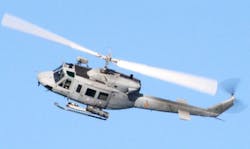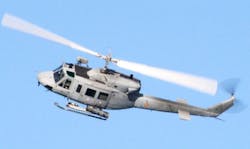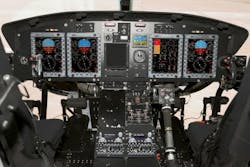Upgraded AB212 helicopter of the Spanish Navy’s 3rd Squadron takes flight
MADRID, 3 Feb. 2014. The helicopter used as prototype in the Spanish Navy’s AB212 Helicopter Life Extension Program (PEVH-AB212) took to the air for its first test flight on 17 December 2013. This flight is the first in a series of tests approved by the National Institute for Aerospace Technology (INTA) through special experimental airworthiness certification (CAE in its Spanish acronym).
This milestone caps off more than three years of concept development, led by the Spanish Navy, with the resulting project being awarded at the end of 2011 to the SENER-INAER AB212 joint venture, formed by the engineering and technology group SENER, which is in charge of the design and integration process, and INAER Helicópteros SAU, which leads installation and certification at its prototype integration center located in Alicante, Spain.
The close collaboration between the Spanish Navy and the joint venture, as well as the participation of INTA from the beginning of the program, was decisive in meeting the demanding security requirements before the experimental airworthiness certification could be issued. Three other aircraft will be added to this prototype during 2014 along with three more in 2015, making up the seven helicopters currently used by the Spanish Navy’s Third Aircraft Squadron.
This ambitious program, a pioneering project for the Spanish aircraft industry, meets all the requirements of the conceptual plan developed by and for the Spanish Navy. The aim of this program is to ensure the versatility of these helicopters beyond 2025. The latest advances in engineering have been applied, in addition to an extensive use of plug-in technology which enables rapid configuration of the helicopter for both its traditional missions for the Third Squadron, and its new missions as organic aircraft working as patrol aircraft for METEORO.
Involving complex design, installation, integration and certification tasks, this is the first program to tackle an upgrade of this scope on helicopters of this type; not only did it involve replacement of the aircraft's electrical system, but also the full substitution of the outdated analog avionics with a fully digital cabin concept, developed specifically for this project in keeping with Navy specifications and after close collaboration with the same body.
The new cabin system incorporates all flight, navigation and engine parameter indicators, all displayed using an electronic flight instrument system (EFIS) containing four digital screens measuring 6X8 inches and which allow for different configurations according to the needs of the crew. In addition a new air data computer (ADC) has been added, as well as an attitude and heading reference system (AHRS). This work also included the replacement of the V/UHF communications and ICS systems with the latest generation devices.
The project includes cutting-edge technology mission systems which the old helicopters lacked, such as: a new radar system for marine and meteorological information; an EO/IR surveillance system; an AIS transceiver for tracking ships; a GPS moving map system and a terrain awareness and warning system (TAWS). A tactical mission controller (TMC) will integrate all signals from these systems and display them on the screens of the EFIS.
In addition to all of the above, the upgrade project will also include the integration of mission and self-protection systems to enable the helicopter to adapt to the various roles assigned to it by the Navy. This new version will feature a crane, modifications to the auxiliary fuel tanks, a missile approach warning system (MAWS), a ballistic protection system in the flight and passenger cabin, armored and anti-crash seats for the crew, and defense weapon systems.
The official handover to the Navy is set for the second half of 2014, once the certification and testing phases that have started with this flight have been completed. In keeping with the initial schedule, the project calendar will be extended through 2015, when the last of the seven upgraded helicopters have been delivered.
The AB212 helicopters and their various configurations, including the anti-submarine warfare carrier (ASW), were purchased by the Spanish Navy between 1974 and 1980. Since then, they have taken part in numerous exercises and national and international operations. Once the upgrade program is finalized, their operating life will be extended beyond 2025.


